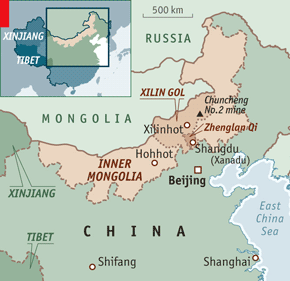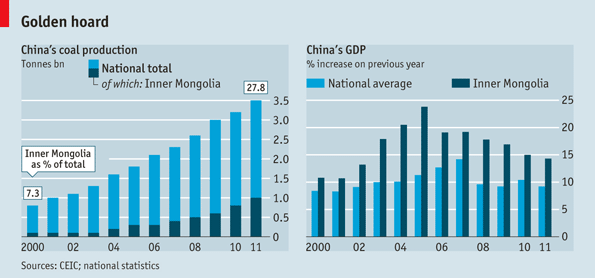| The Economist |
| July 14, 2012 |
| Hohhot and Xilin-Gol |
Soaring demand for a region's minerals stirs unrest and brings challenges for a rising political star
 |
|
At 49, Mr Hu is China’s second-youngest provincial party chief. He is a likely candidate for elevation to the ruling Politburo when China’s “fifth generation” of leaders assumes power in the autumn. He is also widely believed to be close to President Hu Jintao. The two men are not related, but Inner Mongolia’s leader is sometimes referred to as “Little Hu” because of the two men’s similar political backgrounds. As the president once did in Tibet, the younger Mr Hu is preparing for higher office in a border region with a sizeable ethnic-minority population. He is thought to be President Hu’s favourite to head the “sixth generation” of leaders that is expected to take over in 2022. Little Hu’s record in Inner Mongolia will help determine whether he succeeds.
When Mr Hu took up his post in 2009, it might have seemed a cushy assignment. Inner Mongolia’s backward economy was booming thanks to demand for its minerals, ranging from copper to rare earths, but especially its coal. Its ethnic Mongols were far less rebellious than the unruly Tibetans upon whom Hu Jintao imposed martial law in 1989 when he was Tibet’s party chief (Hu Chunhua, who is described in official hagiographies as a fluent Tibetan speaker, was there at the time, too, as a junior official). Inner Mongolia has long been a majority ethnic-Han province, with Mongols making up less than 20% of its 24.7m people (several hundred thousand of them are herders). In May 2011, however, Mongols in Xilin Gol, a sparsely populated prefecture about the size of Britain, rattled Mr Hu by staging the region’s biggest protests in 20 years.
The mining, it turned out, was fomenting instability. By 2009 Inner Mongolia had become China’s largest producer of coal. It is the biggest source of the world’s supply of rare earths. The coal bed around Xilinhot, the capital of Xilin Gol, boasts 38% of global reserves of germanium, a rare earth used in the making of circuitry for solar cells and wind turbines. Ripping up the grasslands and sucking up scarce water for thirsty mines has been part of the price of these “green energy” products.
Boomtown spats
 |
|
Flying into Xilinhot offers a panoramic view of the devastation. Vast open-pit mines that spew clouds of dust into the air scar a landscape that locals say was largely pristine only a few years ago. The coal-driven boom has transformed the city. In the past six years its built-up area has expanded by more than 60%. In 2007 work was completed on a square nearly the size of Beijing’s Tiananmen, with a statue of Genghis Khan on a towering pedestal at its centre. People’s Daily, the Communist Party’s main newspaper, said that a Chinese company had helped cover the cost of the square and a new museum next to it (estimated at around $50m by Xinhua, a state news agency) in return for a cheap-rate mining concession.
Land disputes between miners and Mongol herders became commonplace. In a typical incident, in May 2011, a group of Mongol herders was trying to stop mining lorries crossing and churning up grassland near their homes about 110km (70 miles) north-east of Xilinhot. During the night, a lorry driven by an ethnic Han Chinese driver hit one of the herders, called Mergen (single-named, like many Mongols). It dragged him over the grassland for 150 metres, killing him. Mergen’s death ignited long-festering grievances among the herders. Protests first broke out in the nearby county town, then spread to Xilinhot where hundreds of high-school students in yellow and blue tops marched through the city to the steps of the prefectural headquarters near Genghis Khan’s statue.
The students, in their late teens, were mostly Mongol herders’ children. Unlike their ethnic-minority counterparts in Tibet in 2008 and the Uighur people in the north-western region of Xinjiang in 2009, whose anger erupted into violence against Han Chinese, the Mongol protesters avoided any action or demands that smacked of ethnic conflict. They mainly demanded better measures to protect herders’ property rights and the environment, and the punishment of those responsible for the killing. The protests spread as far south as Zhenglan Qi, an area famous for the overgrown ruins of Kublai Khan’s capital, Shangdu (or Xanadu, as it is known to Coleridge-reading foreigners).
The protesters’ concerns may have seemed innocuous, but the authorities feared that they might open up a new front of nationalist unrest among non-Hans. Mr Hu, the region’s party chief, reacted with a display of might reminiscent of the tactics often used in other, far more volatile, ethnic-minority regions. Paramilitary police were deployed in towns across Xilin Gol. In the provincial capital, Hohhot, university students were temporarily barred from leaving campuses and the central square was sealed off by security forces.
Such a response doubtless earned Mr Hu praise among stability-obsessed leaders in Beijing. Since the unrest, he has shown no sign of loosening his grip. The police are continuing to keep an Inner Mongolian activist, Hada, in what appears to be illegal detention, mostly incommunicado. Hada was released from prison in 2010 after serving a 15-year sentence for “separatism” and spying.
Towards those deemed less of a political threat, Mr Hu has been more conciliatory. In Xilin Gol he tried to win the support of the prefecture’s 200,000 Mongol herders by meting out severe punishment to the offending lorry driver (who was executed) and his co-driver (who was sentenced to life in prison). Mergen’s family was given substantial compensation, neighbours say. The open-cast Chuncheng No. 2 mine near their village, along with dozens of other mines in Xilin Gol, was ordered to close, at least temporarily. The county’s party chief was dismissed. On July 2nd this year a court in Beijing sentenced a former party chief of Xilin Gol, Liu Zhuozhi (who had become Inner Mongolia’s deputy governor), to life in prison for taking bribes, some of which related to Xilin Gol’s mining bonanza.
During the unrest, Mr Hu flew out to Xilin Gol to talk to students at a school near the herder’s home. “If the interests of the masses are not well protected, development cannot be sustained,” he said. His remarks contrasted with the much harsher tone of official rhetoric in response to the unrest in Tibet in 2008 and Xinjiang in 2009. Authorities there blamed the upheavals on agitators based abroad and, unlike Mr Hu, avoided any suggestion that there could be legitimate grievances.
Reining it in
|
|
|
|
|
|
This year, after years of torrid growth (a tenfold increase in provincial coal production—see chart—and a 94-fold increase in Xilin Gol, in the past decade), the Inner Mongolian government promised for the first time to “control” its coal output, which in 2011 was roughly the same as America’s. But it is unclear whether local governments have got the message. Xilin Gol’s latest five-year economic plan, approved early last year, calls for a doubling of coal output by 2015. Big mines like the one being developed near Mergen’s home (which has a projected investment of nearly $1 billion) will be beneficiaries. A sign pointing to it has been blacked out, but residents of the area say they expect it to be allowed to reopen once it has finished building a better road across the grassland. As for the smaller, unlicensed mines, says an ethnic Mongol academic, “even if the government wants to bring them under control, it can’t.” The mine-owners, he says, often use shady connections with local officials to avoid being shut down.
|
|
||
|
No pleasure-domes here |
To the herders, mining brings few obvious benefits. Over the past decade, thanks largely to the rush for resources, Inner Mongolia has recorded the fastest GDP growth of any Chinese province (17% annually on average between 2001 and 2011—see chart). But mine workers are mostly hired from elsewhere, says Sun Xueli of the Inner Mongolia Academy of Social Sciences. Herders also find it hard to find jobs in Inner Mongolia’s prospering cities. Their mother tongue, Mongolian, is unintelligible to most Hans. Some hotels in Hohhot forbid staff from using it, says a Mongol academic.
Government efforts to protect the grasslands from over-grazing are not making the herders’ lives any easier. Even as money-spinning mines have proliferated, restrictions have been imposed on grazing. Over the past decade the government has moved more than a quarter of Xilin Gol’s herders off poor-quality grassland into agricultural or urban jobs. But the policy is resented by some Mongols as an attempt to eliminate herding, which they say the government regards as backward.
It remains unlikely that the herders’ discontent will erupt into the kind of separatist unrest that has periodically roiled Tibet and Xinjiang. Mongols in Inner Mongolia see little attraction in unification with the far poorer Mongolian republic to the north (and few in the republic show much interest in expanding their territory southward). The region has no rallying figure abroad like the Dalai Lama or the Uighur exile Rebiya Kadeer. But grievances over the environment and land rights are widespread across China, as shown last week by large-scale and violent protests against the building of a copper-alloy factory in the south-western city of Shifang. Even if most Mongols are not yearning for independence, Mr Hu cannot relax.
In Xilinhot eight years ago the authorities removed a monument to Communist heroes which stood atop a hill in the city, and reinstated 13 Mongolian ovoo, or stone mounds, that are used in traditional worship (the original ovoo had been flattened by Mao’s Red Guards). Residents say the government’s aim was to bring good luck, but many regret that the once verdant view from the hill, looking away from the city, is now a mine-scarred dust bowl. “They came like ants and ruined it,” says a Han Chinese resident. Yet Mr Hu is unlikely to get black marks for that from the nation’s leaders in Beijing.









